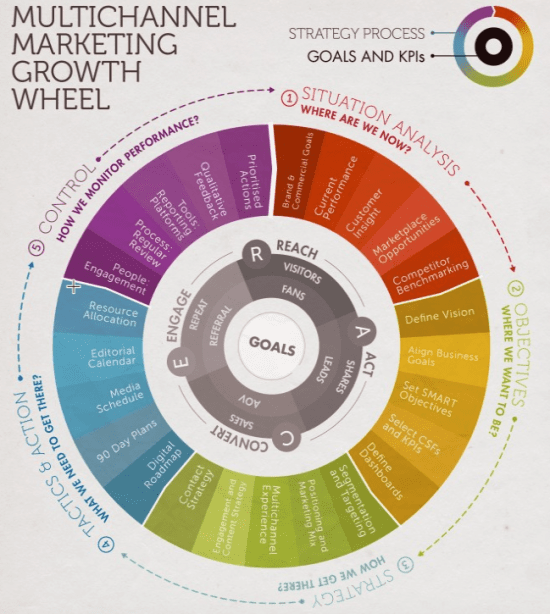What are the essential parts of a business plan template?
Understanding and creating different types of marketing plans and knowing when they are needed is essential to creating a thriving business. But it can be difficult to know which type of plan to use when and how best to structure them. In this article, we look at the essential parts of a business plan and show how to lay it out.
Our new, free PDF download detailing the different types of marketing plans will help you structure different types of plan and gives recommendations on how to make them effective.
What is a business plan?
A business plan is a formal document which outlines organizational objectives and the strategies required in order to achieve those objectives. It identifies how you drive your organization’s future. It aims to answer the question: How do we plan to make our business a success? It is a written record of goals, coupled with a track record of delivering against those goals.
As outlined in the Smart Insights Quick Win Guide and Template – Create a Multi-Channel Marketing Plan, the purpose of a business plan is to define strategies for growing profitability over a long-term period. The scope of a Business Plan is typically 12 months to three years and content usually includes:
- New product development
- Revenue sources
- Means of cost management
The purpose of a business plan is to match targeted opportunities with resources, focused activity and strategies. It supports in guiding and directing different areas of your organization to ensure that you are all working towards the same objectives.
When to use a business plan?
A business plan is used by organizations for establishing and monitoring continuous business growth, remaining competitive and in achieving specific goals. Business plans are typically utilized by organizations when:
- Gaining initial investment as a new-business or startup
- Planning market expansion for an existing company
- Undertaking product development
- Preparing for acquisition
- Planning divestment
- Gaining or sustaining a competitive advantage
- Evaluating resource allocation and strategic goals
Organizations seeking funding require business plans in order to demonstrate the strength of the business and its future to investors.
What should be included? / How should the plan be structured?
A business plan typically defines how an organization will change to become more competitive in future. It typically includes:
- A review of existing financial performance
- Objectives
- Strategies
- Value proposition (products and services)
- Sales
- Marketing tactics including the 7Ps of the marketing mix
- Operations
- Financial forecasting
- Staffing
- Potential threats and challenges
- Tactics
A business plan is an effective way of monitoring progress as it establishes targets in all areas of your business; from sales and expenses to staff recruitment and financial requirements. Once established, these targets translate into performance goals.
A solid business plan has:
- Clear, realistic goals which you can be confident of hitting
- The best strategy to achieve these goals against your competition
- Sufficient details of the tactics and actions needed to translate the strategy into action
- A method to check you are on track with your plans
To make sure your business plan has all the essential features, I recommend the SOSTAC® structure developed by PR Smith—Dave Chaffey’s co-author of the printed book Digital Marketing Excellence.
PR Smith’s SOSTAC® is a great template for structuring business, marketing or digital marketing plans since it’s relatively simple and logical, so it’s easy to remember and to explain to colleagues or agencies. SOSTAC® is a strategic planning process framework that gives you a clear structure to work through to create and manage your plan.
Here’s a summary of how different multichannel marketing activities map to different sections of SOSTAC®. Smart Insights premium members can download PR Smith’s SOSTAC® guide to your Perfect Digital Marketing Plan.
So, what does SOSTAC® stand for?
Situation analysis means ‘Where are we now?’ For business planners, questions include:
- What industry are we operating in?
- What are our products and/or services?
- What is our current business structure?
- What do our cash flow statement, balance sheet and financial ratios look like?
- Are we measuring results accurately?
- Who and where are our customers?
- What are our competitors doing?
- What’s working for them?
Objectives mean ‘Where do we want to be?’ What is the growth forecast? What are the top-level goals 5 Ss (Sell, Serve, Speak, Save and Sizzle)? Here we can build specific and measurable business plan targets. Good objectives are quantified against timescales.
Strategy means ‘How do we get there?’ Strategy summarizes how to fulfill the objectives. It is the shortest part of the plan, but arguably, the most important, as it gives direction to all the subsequent tactics. It answers questions including: how do we position ourselves in order to gain a competitive advantage? How will business plan targets be achieved?
Tactics are the details of strategy. They highlight on a business plan exactly which tactics occur when. To recruit new staff, for example, we would include what methods we will implement to improve our employer brand.
Action is the detailed planning of tactics. Who does what, when and how? What processes and activities are required to make things happen?
Control identifies what you need to measure when, a review process and corrective action when you’re not hitting your targets. The Control section of the plan ensures you know if you are succeeding or failing – and you can make adjustments – before it is too late.
Which type of business is it most suited for?
A common perception is that business plans are formulated by cash-starved start-ups seeking investment to launch a new venture, but a business plan can and should be utilized by businesses of any size, type and at any stage of existence.
Even though the techniques for business planning may vary between different sizes and types of organization, the objective is always the same: to define targeted opportunities to become more competitive with resources, focused activity, and strategies.
In smaller organizations, the business planning process may be more straightforward than for larger organizations with distinct business areas and who may need to make some difficult decisions regarding resource allocations and strategic priorities. This may lead to internal uncertainty and conflict. The business planning process, however, can also be a good opportunity to gather employee feedback on potential ideas and improvements. You could hold a brainstorming session to gather knowledge and get your employee’s support, for example. They will value the opportunity to contribute to the business.
For already established businesses, a business plan will enable you to objectively look at what is working well and areas for improvement. Many business plans are formulated by organizations that are long past the start-up stage. There may be a need for a formalized plan to manage rapid growth, stakeholder expectations or in order to secure funding for growth.
How does it relate to other plans?
A business plan outlines the long-term corporate strategy of a business, which informs and influences other plans within an organization. It is at the top of the business planning hierarchy, covering systems, procedures, resources,
and structure. A marketing plan, however, covers the sales, distribution, communications, and delivery of a product or service, with the aim of achieving the corporate objectives set out in the business plan.
Integrated with a business plan may be, for example, a marketing plan, digital marketing plan, multi-channel marketing plan and/or a campaign plan. The business plan informs these plans and vice-versa.
Different organizations will utilize differing plans, covering different areas and timeframes. What is crucial in a business is that the plans being utilized, the timeframes allocated and how they integrate with each other are collectively established.
To find out about more about how different types of marketing plans and how to structure them, download our free Understanding different marketing plans guide, which includes campaign planning, digital transformation plans and multichannel plans.


